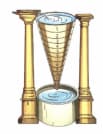Time
Time: Overview
In this topic, we will discuss the vision of time. In classical, non-relativistic physics, it is similar to length, mass and charge are usually described as a fundamental quantity. We will also understand that time is a scalar quality.
Important Questions on Time
The position of the bob when it is at rest is called its extreme position.
The position of the bob of the simple pendulum when it is at _____ is called its mean position.
Draw the diagram of a simple pendulum and show the mean position in the oscillatory motion of the pendulum.
What is the ratio of the lengths of simple pendulum and second's pendulum?
What will be the relation between the time periods to two pendulums of lengths and ?
In ancient times, the time taken between one spring season to the next spring season was called a/an _____.
A simple pendulum takes to complete oscillations. What is the time period of the pendulum?
Name the type of motion in the following:
The motion of the pendulum of a clock.
(Choose from: rotational motion/oscillatory motion/linear motion)
The metallic ball in a simple pendulum is called the _____ (bob/armature).
Name a device which was used earlier to measure time and is based on the shadow of a gnomon formed by the sun.
(Choose from: Sundial/Water clock)
Look at the pictures of the clock used over the ages. How does it work?

Look at the pictures of the clock used over the ages. How does it work?

Look at the pictures of the clock used over the ages. How does it work?

